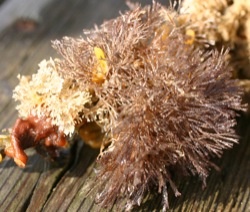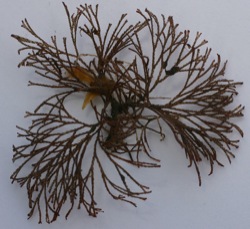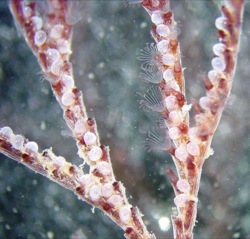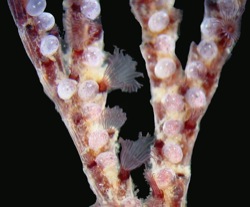Bugula neritina Image 5
A closer detail of the same colony, showing the white ovicells and lophophores.
Return to Top
Bugula neritina Image 4
Detail of the mature portion of a colony from San Francisco Bay. Note the numerous white, globular ovicells, and the lophophores (crowns of feeding tentacles) extending from the zooecia.
Return to Top
Bugula neritina Image 3-from SFBay, branching
A
Bugula neritina colony from San Francisco Bay, showing branching pattern.
Return to Top
Bugula neritina Image 2
A smaller
Bugula neritina colony from San Francisco Bay. The light tan organism to the left is another species of
Bugula, and the red-orange organism below that is
Watersipora subtorquata, another exotic
bryozoan species.
Return to Top
Bugula neritina Key Image
A large
Bugula neritina colony from San Francisco Bay.
Return to Top
Bugula neritina Linnaeus, 1758
Bugula neritina is a colonial animal that grows in upright, bushy,
branching tufts, up to 15 cm or so in height, that are often mistaken for
a seaweed. They are usually a dark red-purple or purple-brown, though occasionally
they are a dull, dark red. Some of the details described below can be seen
with a hand lens; others require a microscope.
Return to Top
Balanus amphitrite 5-B improvisus
Balanus improvisus, an exotic, unstriped, smooth-walled barnacle that has become established in San Francisco Bay.
Return to Top
Balanus amphitrite Image 4
Another
Balanus glandula with strongly ridged walls, flanked by an adult
amphitrite on the left and a juvenile
amphitrite on the right, on a high intertidal rock in San Francisco Bay.
Return to Top
Balanus amphitrite Image 3
A native barnacle (
Balanus glandula) flanked by two
Balanus amphitrite.
Balanus amphitrite’s shell is striped and smooth or sometimes shallowly ridged, while glandula’s is stripeless and often strongly ridged (as here).
Return to Top
Balanus amphitrite Image 2
A side view of another
Balanus amphitrite from San Francisco Bay, with a juvenile growing on it on the right.
Return to Top

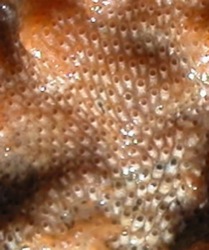 Cryptosula pallasiana
Cryptosula pallasiana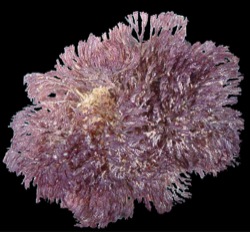 Bugula neritina
Bugula neritina 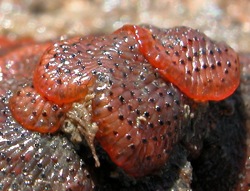 Watersipora subtorquata
Watersipora subtorquata